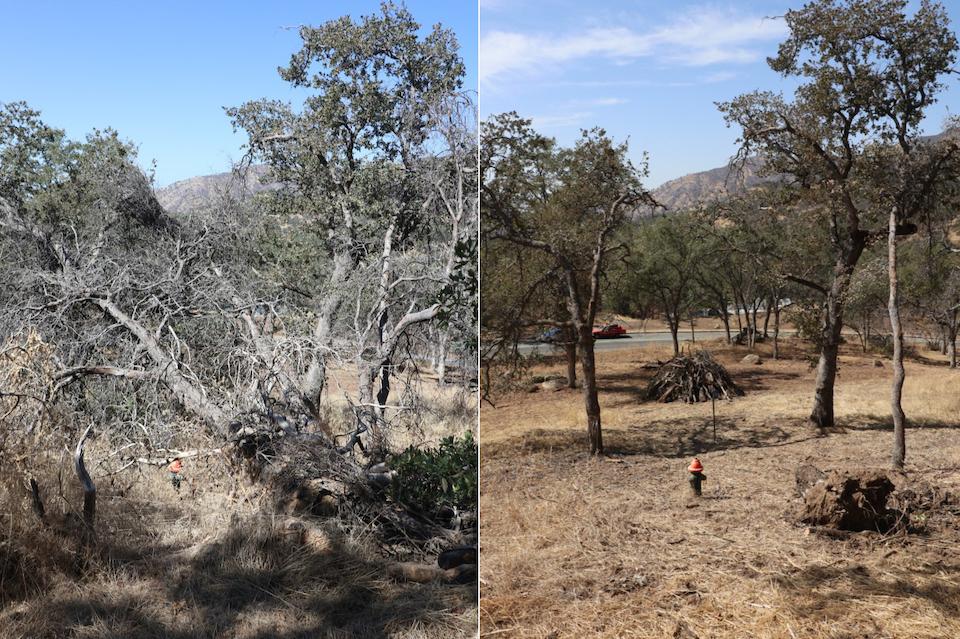
A before and after look at the effectiveness of mechanical treatments and defensible space. Notice the fire hydrant in both pictures/NPS, RPaterson
There were 15 wildfires in Kings Canyon and Sequoia national parks last year, but there would have been much fewer if humans were more careful in the parks.
According to staff for the parks, at least 10 of the fires were started by people. Four were sparked by lightning, and the cause of one start was undetermined.
Against that news, staff points out that mechanical fuels treatments (e.g., using tools to remove vegetation and trees), prescribed burns, and lightning-caused wildfires managed for multiple objectives all play a role in protecting the parks' highly valued resources and assets. The use of a variety of wildland fire management tools makes wildfire management efforts much more safe and cost effective.
The human-caused fires tallied in 2019 trended about the same on a ten-year historic average; however, there was less lightning activity than normal. Lower lightning activity coupled with a very wet winter and spring in the parks in 2019 resulted in lower wildfire acres in the parks, totaling just under 3 acres.
Firefighters and fire personnel additionally responded to mutual-aid fire requests on neighboring lands and supported 97 in-park search-and-rescues. Furthermore, fire staff traveled to 40 off-park fires/incidents in 2019, including assignments as far away as Florida, Alaska, and Alberta, Canada.
As a result of light suppression activity state-wide, fire resources were abundantly available and fire managers were able to utilize these resources to complete four significant projects in 2019 totaling more than 800 acres of mechanical treatments and prescribed burns. The 489-acre Sherman Prescribed Burn in Giant Forest of Sequoia National Park was the biggest highlight of the year. This multipart project built upon decades of previous work maintaining low-intensity prescribed burning in the most visited sequoia grove in these parks. More than 15,000 visitors to the area during ignitions got to see first-hand how carefully applied prescribed burns can better protect these special places for future generations.
“For over 50 years we have successfully reintroduced prescribed burns in this ecosystem,” said John Ziegler, fire management officer for Sequoia and Kings Canyon. “By using scientific parameters and research, these projects don’t just reduce the risk from unwanted high-severity wildfires, but help to ensure the sustainability of our landscapes for generations to come.”
Each year, managers prepare an Annual Fuels Treatment Plan that lists all the approved prescribed burns and mechanical fuel reduction projects that will help the parks accomplish goals. In all, for 2020 there are eight planned projects totaling more than 3,000 acres. Nearly 200 acres will be focused on mechanical thinning treatments to reduce hazardous fuel build up around parks’ headquarters and Grant Grove areas.
Depending on weather and fuel conditions, the earliest projects planned for this year are the 244-acre Cedar Central Prescribed Burn and the 20-acre Ash Mountain Prescribed Burn, which will be done in the spring, conditions permitting. Additionally, the parks are planning for the 470-acre Tharp’s Prescribed Burn, 669-acre Lost Grove Prescribed Burn, 562-acre Park Ridge Prescribed Burn, and the 941-acre Deer Creek Prescribed Burn later in the year.
A full list of the planned projects can be seen by visiting this page. All projects and dates are subject to change based on weather and fuel conditions.
If you are visiting the parks, be aware that fire and smoke can be present at any time. Since the execution of burns depends on air quality, local fire activity, fuel moisture, and weather, the times and dates listed on the website are estimates only.



Add comment